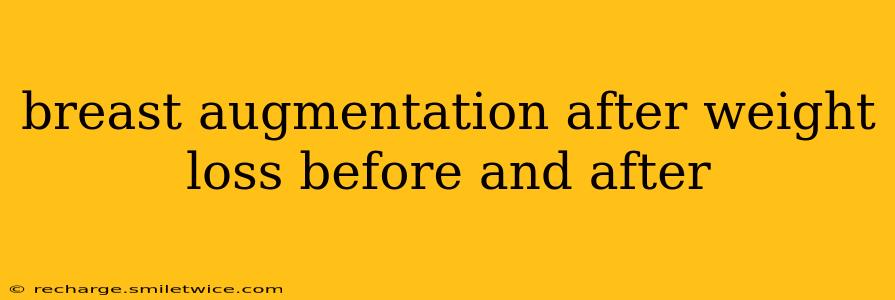Weight fluctuations can significantly impact breast tissue, making breast augmentation after weight loss a complex decision. Many women wonder if it's the right choice for them, and understanding the potential benefits and challenges is crucial. This comprehensive guide explores the before-and-after aspects of breast augmentation following weight loss, addressing common concerns and providing valuable insights.
Is Breast Augmentation Right for Me After Weight Loss?
This is a highly personal question, and the answer depends on several factors. Weight loss can cause breast tissue to lose volume and elasticity, leading to a less full or saggy appearance. If you've achieved a stable weight and are unhappy with the appearance of your breasts after weight loss, breast augmentation might be a viable option. However, it's crucial to consult with a board-certified plastic surgeon who can assess your individual circumstances and determine if you're a suitable candidate. They will consider factors like your overall health, skin elasticity, and the amount of weight you've lost.
What Happens to Breasts After Significant Weight Loss?
Significant weight loss often leads to a decrease in breast size due to the reduction of fat deposits within the breast tissue. This can result in:
- Reduced breast volume: The breasts may appear smaller and less full.
- Breast sagging (ptosis): The skin may lose its elasticity, causing the breasts to droop.
- Changes in breast shape: The overall shape of the breasts might be altered.
It's important to remember that the extent of these changes varies from person to person, depending on factors like age, genetics, and the amount of weight lost.
How Long Should I Wait After Weight Loss Before Breast Augmentation?
This is another crucial question, and there's no one-size-fits-all answer. Most surgeons recommend waiting at least six months to a year after reaching your goal weight before undergoing breast augmentation. This allows your body to stabilize and ensures that the surgeon has a clear picture of your final body shape and composition. Continuing to lose weight after the procedure could negatively impact the results.
What Are the Different Types of Breast Implants?
Several types of breast implants are available, each with its own advantages and disadvantages. Your surgeon will help you choose the best option based on your individual needs and preferences. Common types include:
- Silicone gel-filled implants: These implants are known for their soft, natural feel.
- Saline-filled implants: These implants are filled with sterile saline solution and feel firmer.
The choice between saline and silicone implants depends on your personal preference and the surgeon's recommendation. The size and shape of the implant will also be carefully considered to achieve the desired outcome.
What is the Recovery Process Like After Breast Augmentation?
Recovery from breast augmentation varies but generally involves some discomfort, bruising, and swelling. Your surgeon will provide specific post-operative instructions. You'll likely need to wear a surgical bra for several weeks and avoid strenuous activity for a period of time. The full results of the surgery are usually visible after several months, as the swelling subsides.
Can I Breastfeed After Breast Augmentation?
Generally, breast augmentation does not interfere with breastfeeding. However, it is important to discuss this with your surgeon beforehand to understand any potential impacts on breastfeeding, especially if you have plans to breastfeed in the future.
What are the Potential Risks and Complications of Breast Augmentation?
As with any surgical procedure, breast augmentation carries potential risks and complications, such as:
- Infection: A risk associated with any surgical procedure.
- Capsular contracture: The formation of scar tissue around the implant.
- Implant rupture or leakage: Rare but possible complications.
- Changes in nipple or breast sensation: Temporary or permanent changes may occur.
Your surgeon will discuss these risks in detail and take steps to minimize them.
How Much Does Breast Augmentation Cost After Weight Loss?
The cost of breast augmentation varies depending on several factors, including the surgeon's fees, anesthesia costs, and the type of implant used. It's essential to obtain a detailed cost breakdown from your surgeon before proceeding with the surgery.
Before and After Photos: What Can I Expect?
Before-and-after photos can provide a visual representation of the potential results of breast augmentation. However, it's important to remember that individual results can vary, and these photos are meant to provide a general idea, not a guarantee of your specific outcome. Your surgeon will discuss realistic expectations based on your unique circumstances.
This guide provides a comprehensive overview of breast augmentation after weight loss. Remember, consultation with a board-certified plastic surgeon is vital for personalized advice and a safe surgical experience. Always prioritize your health and well-being throughout the process.
